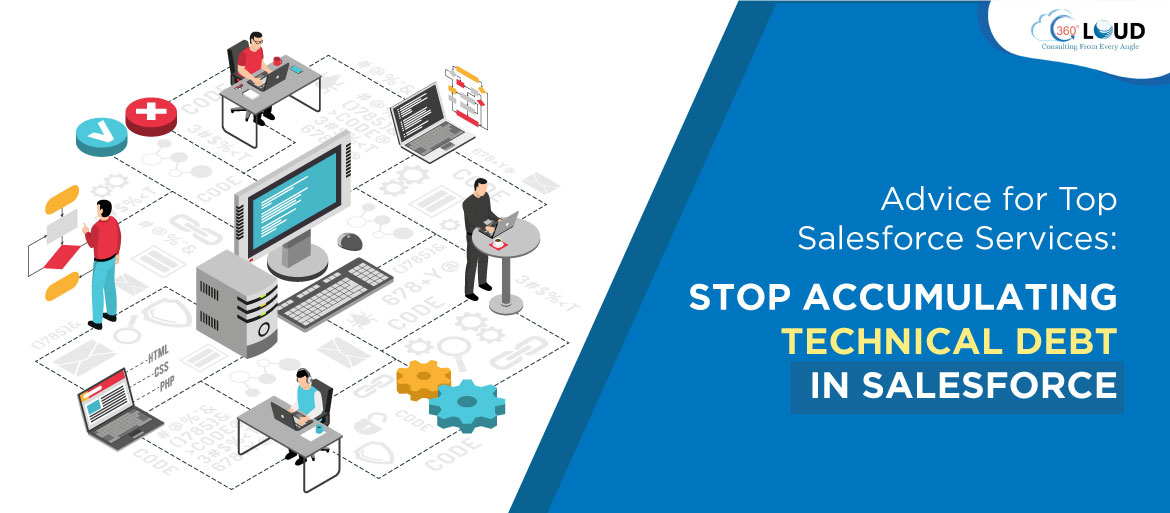Salesforce Orgs become unmanageably complex over time. The complexity can occur because of poor change and release management practices, corporate mergers, and acquisitions, disruptive administrative turnover, or failed development projects. All of the complexities caused by such issues can end up in slow performance, sluggish adoption, reduced agility, and business misalignment.
Managing technical debt in Salesforce is one such challenge almost all enterprises face. As Salesforce instances get older and the services of a company get more complex, it can cause the accumulation of technical debt. Having a small amount of technical debt is quite normal, but a Salesforce org having too much technical debt can be brittle and can lead to performance issues, making it more expensive to maintain with time. This is why most companies go for Salesforce support plans to keep the technical debt at the minimum. Let’s learn more about technical debt and how to avoid it.
What is Technical Debt?
In Salesforce, technical debt extends beyond code and includes overlapped or abandoned processes, custom fields, and workflows. Technical Debt is classified into two segments – it can be incurred or evolved. Incurred technical debt is inadvertently or deliberately accumulated, just like using an obsolete method of solving a problem. An example is to use a Salesforce feature that is about to be retired. On the other hand, the evolved technical debt is created over time because of the changes in your Salesforce org. An example of this is when an organization has to retire a solution because of significant growth in its Salesforce contacts that made the historic solution obsolete.
How do you Avoid Technical Debt in Salesforce?
You have to avoid monopolizing the capacity of your team on fixing and stalling/blocking necessary deployments. Here are some best practices that could be helpful and can result in avoiding the issue of technical debt in Salesforce.
-
Approach Salesforce Holistically
Departments should not request Salesforce customizations in a vacuum. It can end up in overlapping functionalities, leading to technical debt. Go for a Scheduled Release Process for addressing it and make sure that all the major Salesforce updates are aligned on a monthly cadence. You must have a prescribed, regular Salesforce release schedule. It includes all incoming requests being prioritized and visible across the organization. This helps the user to understand what should be covered as part of a monthly release versus what should be prioritized in a Salesforce backlog. Hiring experienced Salesforce customization services can help you out with this.
-
Use Strong Patterns
Salesforce platform is itself a collection of reusable patterns: Process Builder to deliver automation, Lightning Component Framework to create a consistent user experience, or Custom Objects to extend the data model- all of these are strong functional patterns. Salesforce solutions you use for your business should follow a consistent pattern. You must identify those patterns that frequently appear across your business and have a high impact on velocity, then invest in making these patterns strong. In other words, you need to look for the ‘best buy’ patterns to ensure higher efficiency while avoiding technical debt.
-
Reduce Human Intervention with Automation
When moving on with any new system, team members leave behind old processes, workflows, and fields that accumulate and become a plaque. New employees usually don’t have any clue of what exists and/or when human intervention is required in the processes. This, along with a lack of documentation, can become a reason for technical debt. Salesforce support services decrease human intervention wherever possible and automate processes to help to avoid such an issue.
-
Invest in improvements along with new delivery
Teams that don’t invest in improvements quickly burn more than 30% of their time dealing with technical debt. By allocating time upfront and regularly tracking the debt, you can consciously look for the right level of refactoring and deliver a high-value solution instead of building features on shaky foundations that can easily be compromised. While planning at the start of the project, allocating resources away from new features feels like a huge investment. But the payback overtime comes in the form of improved velocity and reduced entropy.
Don’t spiral into a vicious Technical Debt Trap
Companies can use Salesforce Data and APIs to generate reports to visualize the complexity of their Salesforce Org. Most Salesforce accounts get more complex every day with each account adding into it. This makes it important that the cleanup and optimization should become a regular part of the change and release management practice. Or you can make it all go away by letting Salesforce experts handle your Salesforce account, avoiding any technical debt. Contact our Salesforce Professional Services for any such help.


1 comment